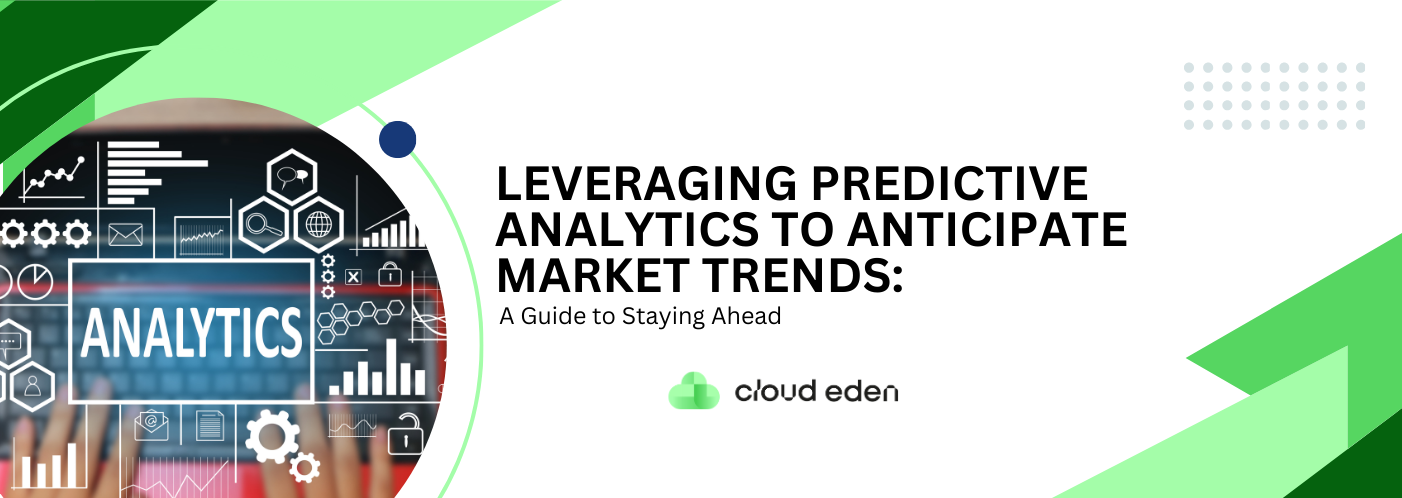Leveraging Predictive Analytics to Anticipate Market Trends: A Guide to Staying Ahead

Table of Contents
1. Introduction
- The Importance of Predicting Market Trends
- How Predictive Analytics Drives Business Success
2. Understanding Predictive Analytics
- What is Predictive Analytics?
- How Predictive Analytics Works in Business
3. Why Predicting Market Trends Matters
- Enhancing Strategic Decision-Making
- Proactive vs. Reactive Strategies
- Gaining Competitive Advantage
- Taking a Customer-Centric Approach
4. Applications of Predictive Analytics in Anticipating Market Trends
- Consumer Behavior Forecasting
- Spotting Emerging Markets
- Optimizing Pricing and Promotions
- Detecting Industry Disruptions
- Streamlining Supply Chain Management
5. Why Cloudeden is a Thought Leader in Predictive Analytics
- Cutting-Edge Technology
- Tailored Solutions
- Data-Driven Expertise
- Proactive Decision-Making
6. How Predictive Analytics Benefits Businesses
- Boosting Revenue
- Improving Customer Retention
- Enhancing Operational Efficiency
- Achieving Better Marketing ROI
7. Conclusion
- Future-Proofing Your Business with Predictive Analytics
- Why Cloudeden is Your Go-To Partner for Predictive Solutions
In an increasingly competitive business environment, understanding and anticipating market trends has become more crucial than ever. Companies that can predict market shifts, customer behaviors, and emerging industry disruptions are positioned to outperform their competitors. This is where predictive analytics comes into play. Leveraging vast amounts of data and advanced algorithms, predictive analytics enables businesses to forecast market trends and make proactive decisions.
Cloudeden, a recognized thought leader in this space, empowers businesses with the tools and insights they need to stay ahead of the curve. In this article, we will explore how predictive analytics can be used to anticipate market trends, its wide-ranging applications across industries, and how Cloudeden is setting the standard for forward-thinking business intelligence.
Understanding Predictive Analytics: The Key to Future-Proofing Business
Predictive analytics is a subset of advanced analytics that utilizes historical data, machine learning algorithms, and statistical models to make informed predictions about future outcomes. By analyzing patterns in past and current data, businesses can make educated guesses about future behaviors. These predictions allow companies to respond to opportunities or challenges before they arise, making predictive analytics a powerful competitive tool.
For businesses looking to remain adaptable and forward-thinking, predictive analytics is essential. The ability to predict customer preferences, market changes, and competitor behavior helps organizations minimize risk, maximize profitability, and stay relevant in fast-evolving industries.
Why Predicting Market Trends Matters
Market trends drive business decisions. Whether it’s understanding what products or services customers will want next, identifying new geographic markets for expansion, or recognizing when consumer sentiment is changing, being able to anticipate market trends provides a distinct advantage. Here’s why it matters:
- Enhancing Strategic Decision-Making: Predictive analytics allows businesses to make data-driven decisions. Instead of relying on intuition or reactive strategies, companies can make informed decisions that align with future market conditions.
- Proactive vs. Reactive: Companies that rely solely on reactive strategies often struggle to adapt to sudden market changes, leading to lost opportunities. In contrast, businesses that use predictive analytics can forecast trends and prepare ahead of time, placing them in a proactive position.
- Competitive Advantage: Predictive analytics provides businesses with insights into what their competitors may not see coming. This means they can introduce products, shift strategies, or adopt new business models faster than competitors who are not leveraging predictive analytics.
- Customer-Centric Approach: Knowing what customers want before they want it gives businesses the ability to tailor their offerings in advance, driving higher customer satisfaction and retention rates.
Applications of Predictive Analytics in Anticipating Market Trends
Predictive analytics has applications across numerous industries, each benefiting from the ability to foresee trends and prepare accordingly. Here are some key areas where predictive analytics makes a substantial impact:
1. Consumer Behavior Forecasting
One of the most significant applications of predictive analytics is in forecasting consumer behavior. By analyzing historical purchase data, browsing history, and engagement metrics, predictive models can identify emerging buying patterns. This data-driven approach allows businesses to predict demand for products and services. For example, a fashion retailer can use predictive analytics to forecast upcoming seasonal trends and stock the right products before competitors catch on.
Cloudeden’s predictive tools go beyond surface-level predictions, offering deeper insights into long-term customer preferences, loyalty patterns, and buying motivators. By tailoring product offerings and marketing strategies to these insights, companies can significantly boost their customer retention and satisfaction rates.
2. Spotting Emerging Markets
Predictive analytics can identify geographic regions or industry sectors experiencing rapid growth, enabling businesses to expand into new areas before the competition. By analyzing regional data trends, industry growth forecasts, and economic indicators, businesses can strategically position themselves in emerging markets. For example, a tech company can use predictive models to spot an uptick in demand for smart home devices in a particular region and enter that market with tailored products and solutions.
Cloudeden specializes in providing insights into emerging markets, giving businesses the information they need to strategically allocate resources, build partnerships, and seize growth opportunities.
3. Optimizing Pricing and Promotions
Pricing plays a crucial role in both consumer demand and business profitability. Predictive analytics allows companies to optimize pricing strategies by anticipating price elasticity, competitive pricing changes, and customer price sensitivity. This helps businesses avoid the pitfalls of overpricing (which could drive away customers) or underpricing (which may erode profit margins). Additionally, predictive analytics can forecast the best times to offer promotions and discounts to maximize sales without sacrificing revenue.
Retailers, in particular, can leverage predictive analytics to time their sales and promotional campaigns effectively. Cloudeden’s proprietary algorithms help businesses anticipate the best pricing strategies and seasonal promotions, ensuring that pricing aligns with both market conditions and consumer expectations.
4. Detecting Industry Disruptions
In fast-paced industries, disruptions can come from various sources: new competitors, regulatory changes, technological advancements, or shifts in consumer preferences. Predictive analytics helps businesses stay one step ahead by identifying these disruptions before they happen. This allows companies to adjust their strategies, adopt new technologies, or even pivot business models in response to changing market dynamics.
For instance, during the COVID-19 pandemic, businesses that had predictive analytics in place were able to adjust supply chains, shift to digital offerings, and communicate effectively with their customers. Cloudeden’s predictive tools helped businesses manage such disruptions by forecasting their impact and recommending responsive strategies.
5. Streamlining Supply Chain Management
Effective supply chain management is crucial for companies to meet consumer demand without delays. Predictive analytics helps optimize supply chains by forecasting demand, identifying potential bottlenecks, and predicting equipment failures. Companies that use predictive analytics can reduce the risk of stockouts or overstocking, ensuring that they meet customer expectations while minimizing inventory costs.
Cloudeden’s predictive analytics models provide actionable insights into supply chain efficiency, helping businesses streamline operations and reduce operational costs.

Why Cloudeden is a Thought Leader in Predictive Analytics
At Cloudeden, we pride ourselves on delivering predictive analytics solutions that go beyond standard business intelligence. Our approach focuses on actionable, real-time insights that drive proactive decision-making. With a deep understanding of both the technology and its applications, Cloudeden helps businesses not only predict but also shape future trends.
Here’s why Cloudeden stands out as a thought leader in predictive analytics:
- Cutting-Edge Technology: Cloudeden leverages the latest advancements in machine learning, artificial intelligence, and big data analytics. Our predictive models are powered by state-of-the-art algorithms that provide precise and timely forecasts.
- Tailored Solutions: We recognize that no two businesses are alike. That’s why our predictive analytics solutions are tailored to meet the specific needs of each client. Whether you are in retail, healthcare, financial services, or manufacturing, we provide customized insights to help you stay ahead of market changes.
- Data-Driven Expertise: Our team of data scientists and industry experts has years of experience in translating data into meaningful insights. We provide businesses with more than just numbers—we deliver strategic recommendations that drive results.
- Proactive Decision-Making: Cloudeden empowers businesses to move from reactive to proactive decision-making. By anticipating market trends, businesses can seize opportunities, mitigate risks, and maintain a competitive edge.
How Predictive Analytics Benefits Businesses
- Boosted Revenue: Predictive analytics ensures that businesses can anticipate customer demand and optimize their offerings accordingly. This leads to increased sales and higher profitability.
- Customer Retention: Predictive analytics helps businesses understand customer behavior and predict when customers might churn. This enables companies to implement personalized retention strategies, driving customer loyalty and lifetime value.
- Improved Operational Efficiency: From inventory management to supply chain optimization, predictive analytics improves operational efficiency by forecasting potential disruptions and inefficiencies before they occur.
- Better Marketing ROI:
Predictive analytics enables businesses to optimize their marketing campaigns by targeting the right customers at the right time. This leads to better conversion rates, higher customer engagement, and a greater return on investment (ROI).
Final Thoughts
In today’s data-driven world, businesses that fail to leverage predictive analytics risk falling behind their competitors. By anticipating market trends, businesses can not only stay ahead but thrive in a constantly evolving landscape. Cloudeden’s predictive analytics solutions offer the tools and insights businesses need to make informed, proactive decisions that drive growth.
If you're ready to harness the power of predictive analytics and stay ahead of market trends, contact Cloudeden today. Let us show you how our industry-leading solutions can transform your business.
Welcome To Our Blog






